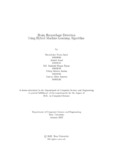| dc.contributor.advisor | Islam, Md. Saiful | |
| dc.contributor.advisor | Rahman, Rafeed | |
| dc.contributor.author | Iqbal, Khondoker Nazia | |
| dc.contributor.author | Azad, Istinub | |
| dc.contributor.author | Emon, Md. Imdadul Haque | |
| dc.contributor.author | Amlan, Nibraj Safwan | |
| dc.contributor.author | Aporna, Amena Akter | |
| dc.date.accessioned | 2022-06-06T05:48:25Z | |
| dc.date.available | 2022-06-06T05:48:25Z | |
| dc.date.copyright | 2022 | |
| dc.date.issued | 2022-01 | |
| dc.identifier.other | ID 18101006 | |
| dc.identifier.other | ID 18101045 | |
| dc.identifier.other | ID 18101049 | |
| dc.identifier.other | ID 18101596 | |
| dc.identifier.other | ID 18301236 | |
| dc.identifier.uri | http://hdl.handle.net/10361/16907 | |
| dc.description | This thesis is submitted in partial fulfillment of the requirements for the degree of Bachelor of Science in Computer Science and Engineering, 2022. | en_US |
| dc.description | Cataloged from PDF version of thesis. | |
| dc.description | Includes bibliographical references (pages 31-33). | |
| dc.description.abstract | Machine learning (ML) helps computers learn and program data without humans’
help. According to data scientists, machine learning can extract 60% high-quality
information, reduce the cost up to 46%, and increase operation speed by approximately
48% [1]. Recently, there has been successful implementation of machine
learning in data analysis, computer vision, computer-aided diseases (CAD), and
many more fields. Machine learning is broadly used in the medical industry because
of its processing power for image data and pattern recognition quality. The image
processing power of machine learning can be used in medical images to classify
the brain images automatically. Segmentation and classification of brain image can
provide valuable information and quantitative assessment of lesions which can be
used for treatment strategies and predicting patient condition (Kamnitsas et al.,
2017). According to research [2], an estimated 64-74 million people in the world
are affected by traumatic brain injury every year. It affects the lives of nearly every
one out of six persons. In our proposed system, we will use a hybrid approach
of multiple machine learning algorithms together for the classification of CT brain
images and diagnose brain disorders and diseases like brain hemorrhage. Some ML
algorithms such as different 3D Convolutional Neural Networks (CNN) , AlexNet,
DenseNet121, GoogleNet and some other models like Multilayer Perceptron Model
(MLP), Support Vector Machine (SVM) and Random Forest (RF) have been applied
successfully in this field in the past. Modifying previous methods, we want
to build a hybrid machine learning algorithm by combining different CNN models
like VGG-16, VGG-19, Random forest and Multilayer Perceptron (MLP) classifiers
for detecting brain hemorrhage. We have used the VGG-16 and VGG-19 model to
derive image features from the CT brain images and Random forest classifier and
MLP classifier for testing the accuracy of our model. To test the efficiency of our
system, we have used CT brain image datasets from Kaggle. The CT brain imaging
data will be the input of our model and our model will detect brain hemorrhage and
classify them into one of six classes: Epidural, Intraparenchymal, Intraventricular,
Subarachnoid, Subdural and No Hemorrhage. Using our hybrid approach the best
accuracy we achieved was around 97.24% using a combined approach of VGG-16
and Multilayer Perceptron classifier. Also we used Explainable AI to explain the
prediction of the hemorrhagic classes. | en_US |
| dc.description.statementofresponsibility | Khondoker Nazia Iqbal | |
| dc.description.statementofresponsibility | Istinub Azad | |
| dc.description.statementofresponsibility | Md. Imdadul Haque Emon | |
| dc.description.statementofresponsibility | Nibraj Safwan Amlan | |
| dc.description.statementofresponsibility | Amena Akter Aporna | |
| dc.format.extent | 33 pages | |
| dc.language.iso | en | en_US |
| dc.publisher | Brac University | en_US |
| dc.rights | Brac University theses are protected by copyright. They may be viewed from this source for any purpose, but reproduction or distribution in any format is prohibited without written permission. | |
| dc.subject | Hybrid machine learning | en_US |
| dc.subject | Convolutional neural network (CNN) | en_US |
| dc.subject | Multilayer Perceptron Model (MLP) | en_US |
| dc.subject | Random Forest (RF) | en_US |
| dc.subject | VGG-16 | en_US |
| dc.subject | VGG-19 | en_US |
| dc.subject | Brain hemorrhage | en_US |
| dc.subject | Explainable AI | en_US |
| dc.subject.lcsh | Machine learning | |
| dc.subject.lcsh | Neural networks (Computer science) | |
| dc.subject.lcsh | Computational intelligence. | |
| dc.subject.lcsh | Mathematical logic. | |
| dc.title | Brain hemorrhage detection using hybrid machine learning algorithm | en_US |
| dc.type | Thesis | en_US |
| dc.contributor.department | Department of Computer Science and Engineering, Brac University | |
| dc.description.degree | B. Computer Science | |

